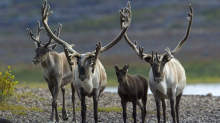 By OLIVER MOORE, Globe and Mail Update
By OLIVER MOORE, Globe and Mail Update
Thursday, Dec. 23, 2010 9:48PM EST At its peak, the George River herd was a spectacle to rival Serengeti migrations. Huge numbers of caribou swept through Labrador each winter, providing native groups with a crucial source of food and cultural identity. Less than 20 years ago, the herd was estimated at close to 800,000. But around the end of the Cold War it reached a tipping point. It grew too big for its range and began to collapse. The latest official estimate puts the George River population at barely 74,000 – down about 90 per cent. “It’s their meat for most of the year,” said Darryl Shiwak, First Minister of the Nunatsiavut government, which represents the Inuit. “People have a real sense of urgency that something needs to be done.” The specific figures are doubted by some native leaders, but the trend is clear. And the precipitous decline raises difficult questions about how to balance conservation with traditional rights – and whether it’s wise, or even possible, to stop this decline. The current situation is worrisome. Caribou go through cycles and this herd has crashed before, bottoming out about a century ago and remaining low for decades. Famine among natives has accompanied previous declines and, although that wouldn’t be allowed now, there is increasing concern over how low the caribou will go this time. “It’s going to be devastating,” said anthropologist Stephen Loring, with the Smithsonian National Museum of Natural History, who has done field work in Labrador with the Innu. He noted that other traditional sources of food are increasingly less available. “They’re up the creek if they don’t have caribou,” Dr. Loring said. “Country food is just a gazillion times better than anything you can get in the store.” The herd was first surveyed by Tom Bergerud, the former chief biologist of Newfoundland and Labrador, who pegged it at 15,000 animals in the 1950s. Now retired, he warned that the caribou will have to find a natural equilibrium with their predators before starting to claw their way back. “The wolves will [disappear] again, they can’t live without the caribou,” he said. “You’ll break out of this [crash] for sure when the wolves are gone. The wolves were gone at 15,000. We don’t have to go that low if the natives will shoot only the males.” … Micheline Manseau, associate professor at the Natural Resources Institute at the University of Manitoba, believes that population fluctuations should be viewed as a “natural phenomenon” instead of a crisis demanding intervention. “We don’t want to manage them so much they lose what is natural,” she said. “You have to be quite careful thinking [we] can control this. You have to be sure we don’t screw it up.” These questions have gained widespread urgency in recent years as caribou herds plummeted across the North. The declines have led conservation groups such as the Canadian Boreal Initiative to call for a greater focus on habitat protection, arguing that the business-as-usual approach clearly isn’t working, and scientists are trying to determine if there are overarching factors. … Anne Gunn, a retired biologist who worked with caribou in the North for 30 years, said that hunting restrictions can slow the decline and help raise the odds of a recovery. “Once caribou reach low numbers, you’re kind of poised; it can go either way,” said Dr. Gunn, who is still active with the CircumArctic Rangifer Monitoring & Assessment Network, a collaborative body that studies caribou and reindeer. “What we do during these periods of low numbers can have an effect on the rate of recovery.” … How low the herd will go and how long it will stay there is anybody’s guess. And experts differ on whether the cyclical history is enough to assume that the caribou will bounce back again. Dr. Gunn is also concerned that the decades-long cycles of the caribou mean they will be trying to recover into a world different than the one they inhabited previously. She points to the effects of climate change and said that the ever-increasing encroachment of development will pose a threat. Biologist Jim Schaeffer, a professor at Trent University in Peterborough, Ont., argues that we will need to give them room. “This is the most mobile land animal on the planet,” he said. “ If we want to have that kind of magnificent migration, space is what we’re going to have to provide.” …
Caribou crisis in Labrador
By OLIVER MOORE, Globe and Mail Update